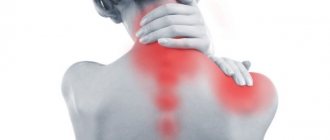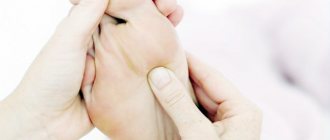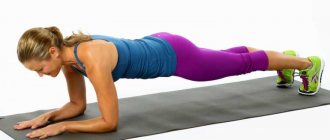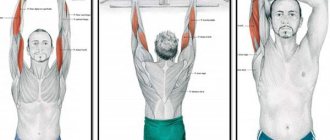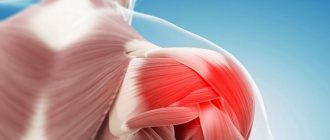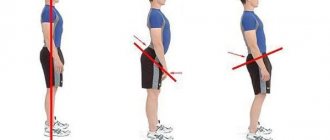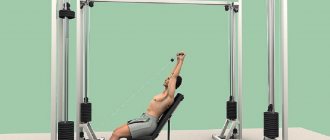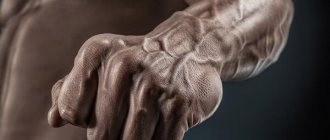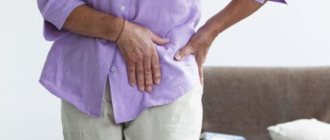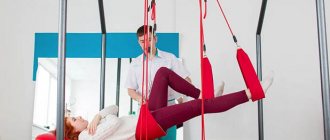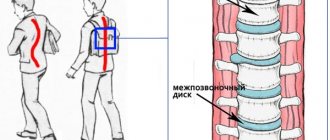- July 25, 2018
- Workouts in the gym
- Zhanna Chuvashova
A beautiful, slender body starts with toned buttocks. Yes, yes, exactly from them. A saggy butt does not please anyone: neither the female nor the male. It is jokingly compared to the human brain, drawing a parallel between its role in consciousness and the place of the fifth point in the formation of an elegant figure. And even confidence arises in this area. After all, it is the symbolic source of life and the ability to survive, the ability to stand firmly on one’s feet: both physically and on a more subtle level. But that’s not about that now.
In the article we will only talk about how to find the ideal muscle shape and give exercises for the buttocks without putting stress on the knees. So, let's go!
A little about the role of muscles
The gluteal muscles in both women and men are made up of three separate ones: small, medium and large.
- The larger one, the most massive of this group, is diamond-shaped. As a rule, it completely covers the other two muscles and acts as the main one for working out, since this area of the body receives its volume precisely thanks to it.
- The middle one has a trigonal appearance and is located under the large one, but can be traced from behind and from the side. It plays a key role in the formation of volume in the upper buttocks and gives the butt “completeness”. And it is this part of the body that is responsible for the so-called dimples.
- The small one is the deepest of all. The shape is similar to the previous one, only thinner, and it is completely covered by other gluteal muscles.
Where to begin
Before you start a set of exercises for the buttocks and thighs, you need to configure the muscular system for the main load. Stretching is perfect, which is important both at the beginning and at the end of the complex.
It is ideal to perform several bends to the knees from a standing position, feel how the back muscles are stretched and the hamstrings “turn on”. You can also stretch in a lying position: arms above your head, with a little effort we pull your body up, and at the same time your legs stretch with your toes in the opposite direction. As soon as the body has reached the required tone, you can begin the main load.
Below is a set of exercises for the buttocks without putting stress on the knees. They can be performed in the sequence in which they are described, or in accordance with the characteristics of a particular organism, you can modify their order yourself.
Fat burning workout without jumping and running: what's the point?
By and large, any activity performed with a heart rate of 60-70% of the maximum can be considered fat burning. But it's better if the cardio you choose also strengthens your muscles. “The complex that I will show today consists of functional exercises. If you perform them at a fast pace and work in the fat burning pulse zone, you can pump up the main muscle groups well and reduce the fat layer, says Alexandra Chuprakova. “Make sure that when performing all exercises, the abdominal muscles are toned and the spine is elongated.” You can perform the exercises at home using our videos .
Don't forget that nutrition is of fundamental importance for weight loss. By building it according to these principles , you will achieve the desired result many times faster than with training alone.
Swing back, forward and sideways from a standing position
These exercises are good as the beginning of a complex for pumping the gluteal muscles. For problem kneecaps, this type of load must be performed while standing; the option of resting on your knees is not suitable.
- The main areas that are involved when performing back swings are the gluteus maximus and the hamstrings.
Execution: stand up straight, resting your hands on a surface, such as a wall. You need to pull the toe of your foot towards you and move your leg back without bending the knee. The abduction angle is maximum in accordance with physical capabilities at the initial stage. Then the leg returns to its original position.
10-15 repetitions for each leg.
An important point: you should avoid excessive arching in the lower back. This will lighten the load, since the work is being done on the buttocks and thighs.
The next element of the complex is also a very good exercise for the legs without putting stress on the knees.
- Swing forward. They warm up the front of the thigh.
Execution: the starting position is similar, i.e. stand straight with support on your hands. The toe is still on you. Raise your leg forward as high as your physical fitness allows. The back remains straight. Then the leg drops.
10-15 repetitions for each leg.
- Swing to the side. The gluteus medius muscle, which is responsible for the rounded shape of the butt, receives a significant load.
Execution: stand up straight, straighten your back and stretch your arms forward (to establish balance). Inhale, pull your toe towards you and move your straight leg to the side with maximum amplitude. As you exhale, the leg lowers to its original position.
10-15 repetitions for each leg.
Workout to burn fat at home
Circuit cardio training consists of 5 exercises.
The first round is 5 exercises, there is no rest between approaches, but if it is very difficult, then a break of no more than 15 seconds is allowed.
Rest between circles for 1.5-2 minutes . Perform from 3 to 5 circles depending on physical fitness.
- bicycle - 30 sec;
- rock climber - 30 sec ;
- one-sided plank - 30 sec on each side;
- hip abduction to the side 15 repetitions on each leg;
- high chair - 30 seconds.
Reference! If you feel dizzy or nauseous during cardio training, immediately stop the complex, eat a piece of sugar, and wait until your heart rate returns.
Dumbbell Row
This is one of the most effective exercises for the buttocks for beginners to improve this area. It is aimed primarily at the biceps of the thigh and buttocks, and differs from the classics in that it is “those” muscles that are maximally involved here.
Execution: stand straight and place your feet shoulder-width apart, place dumbbells on the floor on the sides of your feet. This is followed by bending: the body is directed downwards, in the hands of a dumbbell, while the knees are slightly bent, and the back is straight, taut, like a well-tuned guitar string. Next, the body is raised along with the dumbbells to a level just above “parallel to the floor.” Then, as you inhale, it lowers again, holding the lower position for a couple of seconds, and as you exhale, it rises again.
At least 10 times, 2 approaches.
Important details:
- when performing, dumbbells seem to slide down the body; they must be kept extremely close to the surface of the thigh;
- the knees remain practically motionless to avoid unnecessary stress on them, only the back extensors work;
- The legs should not be straightened completely to avoid excessive stress on the hamstrings;
- Your arms should remain extended, holding the weight close to your hips.
In what cases is physical activity excluded?
Any physical activity and exercises, including immobilization of the joint, are prohibited in the following cases:
- acute phase of injury,
- damage or tear of the meniscus,
- arthritis, osteoarthritis and other joint diseases in the acute stage,
- neoplasms in the joint and tissues surrounding it.
General rules for performing exercises for knee pain
If you have knee pain, you should approach training with extreme caution so as not to aggravate the situation or injure the joint. Following these simple rules will help make fitness classes comfortable and healthy:
- Don't exercise if your knee hurts.
- Do not take painkillers, wait until the pain subsides naturally.
- If there is swelling and redness in the joint area, postpone the workout.
- Always start your workout with a warm-up.
- Start with the exercises that are easiest for you, gradually moving on to difficult ones.
- Start the movement slowly and smoothly, slightly bending and straightening your knee. Increase the range of motion gradually.
- Move as smoothly as possible, without sudden jerks or accelerations.
- If you feel pain while doing exercises, you should stop exercising.
An important aspect of physical therapy exercises is regularity. Frequent but not too long sessions will help keep your muscles toned.
Rise
This exercise for the buttocks without putting stress on the knees is familiar to absolutely everyone from school called “Bridge”. But it is not a fact that everyone performed it correctly at the time. When performed properly, it maximally utilizes all the muscles in question, as well as the biceps and quadriceps of the thigh.
Execution: lie with your back on the floor, arms at your sides, place your knees so that both feet, placed shoulder-width apart, fit well to the floor. From this position, lift your pelvis, placing support on your heels and pulling your buttocks into you as much as possible. Once at the top, hold on for at least a couple of seconds. Then smoothly lower the body, without allowing the muscles to relax; they should remain toned and not touch the floor surface.
Number of executions: 10 times, 2-3 approaches.
Important details:
- shoulders should be pressed to the floor;
- starting from the point of the knees to the shoulder joint, a relatively straight line should be formed: this can be considered an ideal bridge.
Also, for more effective performance of this exercise for the muscles of the buttocks, it is possible to use additional equipment, which should be placed directly in the abdominal area. Due to the fact that there is no flexion of the knee joint, the weight will be directed directly to the gluteal region.
Stretching
Stretching should occupy an important place in any training process. Immediately before cardio training, it protects against injury, increases strength, develops flexibility, increases blood flow and nourishes muscles. Exercises that will improve your well-being:
- While sitting on the floor, stretch your legs and reach your toes with your hands, slightly bending your legs at the knee joints. Hold the position for 30 seconds.
- Standing on one leg, press one leg with your heel to your buttock. Stretch each leg for 30 seconds.
- With your palms clasped at the back of your head, move your pelvis forward so that from the outside it looks like a question mark. Stretch for 30 seconds.
For each exercise, perform 3 sets of 30 seconds.
Scissors
This exercise is also a safe option for pumping the buttocks for the knee area, since when performed they are fixed, only the desired area is tensed. The middle muscle of the fifth point is mainly involved here. And the press also works very well. So, it is also a very effective exercise without stress on the knees for weight loss, since it activates the digestive processes in the body.
Execution: lie on your back, place your hands (palms facing the floor) under your butt or strictly on the sides of the body, raise your straight, tense legs up, forming an angle of 90 degrees with respect to the body. While inhaling, spread your straight legs as far apart as possible, as far as stretching allows, hold for a second and, as you exhale, bring them to the starting point. The movement resembles the opening and closing of scissors.
15 repetitions, 2 sets.
How to understand how well the knee joint is working
If you want to understand where you are now and how well your knee joints are working, then do a simple musculoskeletal assessment, testing the muscles, tendons and ligaments of the knee joint.
To do this, just perform a simple test: take off your shoes and socks, now stand on one leg and see what happens. If you feel uncomfortable and have to swing your arms to keep your balance, it means the muscles around your knee joint are unable to respond to changing conditions in time.
And this is direct evidence of their weakness, which may well lead to knee injuries while running, playing football, jumping and sudden changes in direction of movement when walking quickly.
The best thing you can do now is to start training your knee muscles. Strong muscles will better hold the joint in place, will not allow it to move even during heavy loads, and will serve as excellent support for the knee tendons.
Swing on the floor
Another exercise for the buttocks without stress on the knees looks very good as a finishing maneuver. It is mainly aimed at giving shape to the gluteus minimus and gluteus medius muscles.
Execution: lie on a flat surface on your left/right side and stretch your legs, one hand is at chest level on the floor, and the other elbow serves as a support. The straightened leg is abducted with maximum upward swing, as far as the physical compliance of the hip joint allows. The lower leg can be slightly bent to avoid swaying back and forth. Next, the leg returns to its original position.
10-15 repetitions, 2 sets.
Important details:
- by lowering the working leg, you can move it forward slightly, which will provide better stretching of the buttocks; and when lifting, slightly back, which will give a better contraction of the muscle.
Exercises for arthrosis
With arthrosis in severe form or in the acute stage, any exercise will be not only ineffective, but also unsafe, however, at the early stage of the disease, physical activity will help maintain joint mobility and improve their blood supply. All exercises should be performed slowly and carefully, gradually increasing the range of motion and without sudden jerks or accelerations.
- Lying on your back, lift your leg and hold it on weight for 5-8 seconds. There is no need to straighten your leg completely.
- Lying on your back, lift your leg. Holding it in the upper position, bend and straighten it several times. Slowly lower and repeat the exercise with the other leg.
- Lying on your back, slowly rotate your legs as if you were pedaling a bicycle.
- Lying on your stomach, bend your knee and try to touch your buttock with your heel. Hold this position for a few seconds, supporting your foot with your hand if necessary.
- Leaning your hand on the back of the chair, slowly lower yourself into a half-squat and rise up just as slowly. Repeat several times.
Additional exercise with fitball
If you also have a special exercise ball at home, you can master another simple exercise to pump up the buttocks with a gentle load on the knee joint.
Execution: stand up straight, place a fitball in front of you (by the way, it can be replaced with another large object), and try to step over the ball, going around it first with your right and then with your left legs alternately.
This exercise without stress on the knees can be performed in isolation, when you have 10 minutes of free time and you cannot allocate an extra minute during the day to work on the area in question.
10-15 repetitions for each leg.
Author's methods
Among the many exercises developed specifically to combat pain in the knee joints, there are several proprietary techniques that deserve attention.
Gymnastics for knee joints according to Bubnovsky
Doctor Bubnovsky's technique
The system of exercises developed by doctor Sergei Bubnovsky in combination with general hardening of the body is aimed at preventing degenerative changes in joint tissues. The main idea of the author of the method was to develop a training regimen and general strengthening procedures that would help the body independently resist the disease without resorting to the help of medications. The author recommends combining exercises with cold water douches, ice wraps and massage.
Igor Grishin’s technique “Living knees”
Igor Grishin, aka Master Go, is the author of the “Living Knees” method, a teacher of martial arts. After he was diagnosed with arthrosis, Grishin decided to independently develop an exercise program aimed at combating joint pain. Grishin’s technique is a combination of physical exercises, breathing exercises and spiritual practices.
Valentin Dikul's technique
The technique of former weightlifter Valentin Dikul will help in cases where knees, elbows and hip joints hurt. In his program, a specialist in musculoskeletal disorders suggests combining exercises with stretching. The complex he developed helps restore joint mobility, elasticity and reduce pain.
